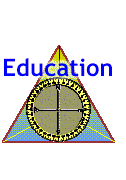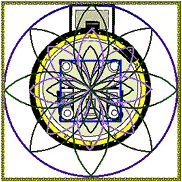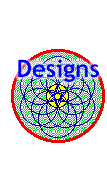
| The Hexagon, The Solstice & The Kiva | References |
 |
||
 |
 |
 |
 |
||

| The Hexagon, The Solstice & The Kiva | References |
 |
||
 |
 |
 |
 |
||
| Endorsements | References |
NATIVE AMERICAN GEOMETRY is a physical, proportional geometry that originates from the simple circle. A growing body of architectural and iconographic evidence from Native America suggests it was a relatively common tradition that has been practiced for at least two thousand years. This is the same type of geometry that was discovered and developed by the ancestors of many peoples in many places, from China to the Mediterranean Basin to the British Isles. Currently, it resides among the logo designers of Madison Avenue. Generally, it maintains a similar methodological structure to the Middle Eastern tradition of classical geometry that is limited to operations carried out by the compass and straightedge, or two sticks and a rope.
In the anthropological world, there are generally two ways traditions come into being in any particular culture: diffusion or borrowing from another culture; and, independent invention or discovery.
Did the geometry have a single source and diffuse around the world over a period of several millennia? Or is there something about it, like stone working techniques, that made it independently accessible to the human mind in diverse cultures and civilizations?
Personally, I believe the geometry was discovered independently by widely disparate cultures. Why? Because this type of proportional geometry originates with the circle, one of the most popular and multi-cultural symbols in the human world. It is a shape that served as a foundation for countless domestic and ceremonial structures. Given the intimate relationship between the circle's radius and the hexagon, it is an argument I can live with, for now. This opinion does not exclude instances of cultural diffusion within specific geographic regions.
The site is divided into four areas:
| Interdisciplinary Recognition of Native American Geometry | |
|
Britannica.com February 2000
"...our editors have selected your site as one of the best on the Internet when reviewed for quality, accuracy of content, presentation and usability." |
|
|
Archaeology Magazine
(Archaeological Institute of America) "Explore the human past with the premiere publication devoted to worldwide archaeological discovery. Exclusive online articles and links to related sites."
The Tech Museum of Innovation
NEW
Nation Council of Teachers of Mathematics
Canadian Mathematical Society
Centre for Experimental & Constructive Mathematics at Simon Fraser University
New Scientist
Southwest Archaeology Net
Davis Dyslexia Association Intl
Digital Dozen
Family Education Network
BONUS.COM
Alaska Native Knowledge Network
Native American Resources
Interdisciplinary Educational Curriculum
|
Din� College
Navajo Central Website
Tribal Librarians
4Directions Project
Index for Native American Resources
Int�l Study Group in Ethnomathematics
Heritage Education Project
EXPLORATORIUM
Tucson Unified School District
Grand Valley State University
Mathematics Archives
The Global Distance Learning Channel Yahoo! Society and Culture...Native American Special thanks to Vino |
Copyright Chris Hardaker 1994-2000